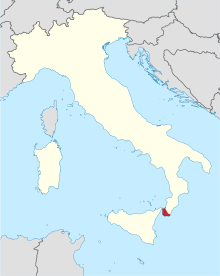Roman Catholic Archdiocese of Reggio Calabria-Bova
Archdiocese of Reggio Calabria-Bova Archidioecesis Rheginensis-Bovensis | |
|---|---|
 Reggio Calabria Cathedral | |
| Location | |
| Country | Italy |
| Ecclesiastical province | Reggio Calabria-Bova |
| Statistics | |
| Area | 1,004 km2 (388 sq mi) |
| Population - Total - Catholics | (as of 2010) 282,240 278,500 (98.7%) |
| Parishes | 119 |
| Information | |
| Denomination | Catholic Church |
| Rite | Roman Rite |
| Established | 1st century |
| Cathedral | Basilica Cattedrale di Maria SS. Assunta in Cielo (Reggio Calabria) |
| Co-cathedral | Concattedrale della Presentazione della Beata Vergine Maria (Bova) |
| Current leadership | |
| Pope | Francis |
| Archbishop | Sede vacante |
| Map | |
 | |
The Archdiocese of Reggio Calabria-Bova (Template:Lang-la) is a Roman Catholic ecclesiastical territory in Calabria, southern Italy.[1] It was created in 1986, when historic Archdiocese of Reggio was combined with the Diocese of Bova.[2]
History
Through a misinterpretation of Acts 27:13, St. Paul was said to have preached the Gospel at Reggio Calabria, and to have consecrated his companion, St. Stephen, bishop. The first bishop known is Mark, legate of Pope Sylvester at the Council of Nicaea (325).
When all Southern Italy was united to the Patriarchate of Constantinople, Reggio became a metropolitan see with thirteen suffragans, and followed the Greek Rite, which was changed to the Gallican Rite after the Norman Conquest; Archbishop Ricciulli adopted the Roman Rite in 1580. The Greek Rite, however, remained in force in the church of Santissima Maria della Cattolica, built by King Roger, and governed by a protopope with a numerous Greek clergy. Questions of jurisdiction caused frequent controversies with the archbishop. About 1600 Archbishop Annibale degli Afflitti suppressed the Greek Rite in that church, and the entire diocese now follows the Roman Rite.
List of bishops
Other bishops:
- St. Sisinnius (536), mentioned in the Acts of St. Placidus;
- John, legate of Pope Agathus at the Sixth Council (680);
- St. Cyrillus (749);
- Leontius, follower of Photius (869);
- St. Eusebius (d. 916).
- Rangerio (1192);
- Fra Gentile (1279), Franciscan;
- Pietro Filomarino (1404);
- Matteo Ricci (1453), restorer of the cathedral;
- Gerolamo Centelles (1529), reformer of ecclesiastical discipline;
- Gaspare Ricciulli (1560), at the Council of Trent, rebuilt the cathedral which had been destroyed by the Turks;
- Mariano Ricciardi (1855–71), exiled after the annexation of the Kingdom of Naples;
- Cardinal Gennaro Portanova (1888).[2]
- Carmelo Pujia (1927-1937)
References
- ^ Reggio di Calabria - Catholic Encyclopedia article
- ^ a b Catholic Hierarchy page
![]() This article incorporates text from a publication now in the public domain: Herbermann, Charles, ed. (1913). Catholic Encyclopedia. New York: Robert Appleton Company.
This article incorporates text from a publication now in the public domain: Herbermann, Charles, ed. (1913). Catholic Encyclopedia. New York: Robert Appleton Company. {{cite encyclopedia}}: Missing or empty |title= (help)
External links
38°06′29″N 15°38′40″E / 38.10806°N 15.64444°E
